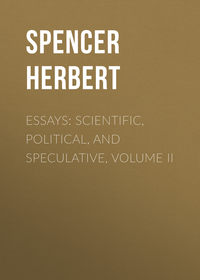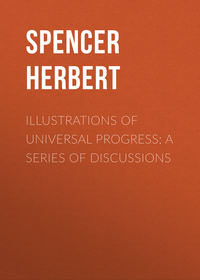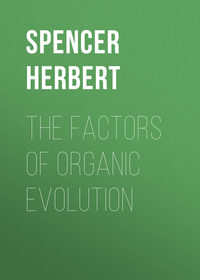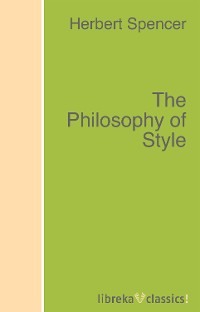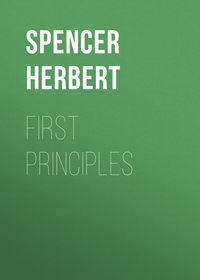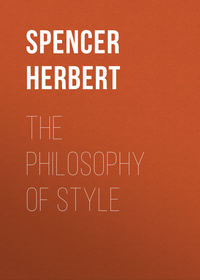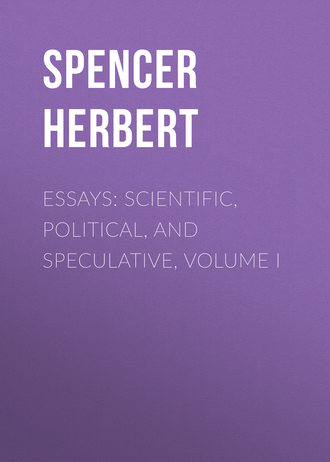 полная версия
полная версияEssays: Scientific, Political, and Speculative, Volume I
Strange as it seems then, we find that all forms of written language, of Painting, and of Sculpture, have a common root in the politico-religious decorations of ancient temples and palaces. Little resemblance as they now have, the landscape that hangs against the wall, and the copy of the Times lying on the table, are remotely akin. The brazen face of the knocker which the postman has just lifted, is related not only to the woodcuts of the Illustrated London News which he is delivering, but to the characters of the billet-doux which accompanies it. Between the painted window, the prayer-book on which its light falls, and the adjacent monument, there is consanguinity. The effigies on our coins, the signs over shops, the coat of arms outside the carriage panel, and the placards inside the omnibus, are, in common with dolls and paper-hangings, lineally descended from the rude sculpture-paintings in which ancient peoples represented the triumphs and worship of their god-kings. Perhaps no example can be given which more vividly illustrates the multiplicity and heterogeneity of the products that in course of time may arise by successive differentiations from a common stock.
Before passing to other classes of facts, it should be observed that the evolution of the homogeneous into the heterogeneous is displayed not only in the separation of Painting and Sculpture from Architecture and from each other, and in the greater variety of subjects they embody, but it is further shown in the structure of each work. A modern picture or statue is of far more heterogeneous nature than an ancient one. An Egyptian sculpture-fresco usually represents all its figures as at the same distance from the eye; and so is less heterogeneous than a painting that represents them as at various distances from the eye. It exhibits all objects as exposed to the same degree of light; and so is less heterogeneous than a painting which exhibits its different objects and different parts of each object as in different degrees of light. It uses chiefly the primary colours, and these in their full intensities; and so is less heterogeneous than a painting which, introducing the primary colours but sparingly, employs numerous intermediate tints, each of heterogeneous composition, and differing from the rest not only in quality but in strength. Moreover, we see in these early works great uniformity of conception. The same arrangement of figures is perpetually reproduced – the same actions, attitudes, faces, dresses. In Egypt the modes of representation were so fixed that it was sacrilege to introduce a novelty. The Assyrian bas-reliefs display parallel characters. Deities, kings, attendants, winged-figures and animals, are time after time depicted in like positions, holding like implements, doing like things, and with like expression or non-expression of face. If a palm-grove is introduced, all the trees are of the same height, have the same number of leaves, and are equidistant. When water is imitated, each wave is a counterpart of the rest; and the fish, almost always of one kind, are evenly distributed over the surface. The beards of the kings, the gods, and the winged-figures, are everywhere similar; as are the manes of the lions, and equally so those of the horses. Hair is represented throughout by one form of curl. The king's beard is quite architecturally built up of compound tiers of uniform curls, alternating with twisted tiers placed in a transverse direction, and arranged with perfect regularity; and the terminal tufts of the bulls' tails are represented in exactly the same manner. Without tracing out analogous facts in early Christian art, in which, though less striking, they are still visible, the advance in heterogeneity will be sufficiently manifest on remembering that in the pictures of our own day the composition is endlessly varied; the attitudes, faces, expressions, unlike; the subordinate objects different in sizes, forms, textures; and more or less of contrast even in the smallest details. Or, if we compare an Egyptian statue, seated bolt upright on a block, with hands on knees, fingers parallel, eyes looking straight forward, and the two sides perfectly symmetrical in every particular, with a statue of the advanced Greek school or the modern school, which is asymmetrical in respect of the attitude of the head, the body, the limbs, the arrangement of the hair, dress, appendages, and in its relations to neighbouring objects, we shall see the change from the homogeneous to the heterogeneous clearly manifested.
In the co-ordinate origin and gradual differentiation of Poetry, Music, and Dancing, we have another series of illustrations. Rhythm in words, rhythm in sounds, and rhythm in motions, were in the beginning parts of the same thing, and have only in process of time become separate things. Among existing barbarous tribes we find them still united. The dances of savages are accompanied by some kind of monotonous chant, the clapping of hands, the striking of rude instruments: there are measured movements, measured words, and measured tones. The early records of historic races similarly show these three forms of metrical action united in religious festivals. In the Hebrew writings we read that the triumphal ode composed by Moses on the defeat of the Egyptians, was sung to an accompaniment of dancing and timbrels. The Israelites danced and sung "at the inauguration of the golden calf. And as it is generally agreed that this representation of the Deity was borrowed from the mysteries of Apis, it is probable that the dancing was copied from that of the Egyptians on those occasions." Again, in Greece the like relation is everywhere seen: the original type being there, as probably in other cases, a simultaneous chanting and mimetic representation of the life and adventures of the hero or the god. The Spartan dances were accompanied by hymns and songs; and in general the Greeks had "no festivals or religious assemblies but what were accompanied with songs and dances" – both of them being forms of worship used before altars. Among the Romans, too, there were sacred dances: the Salian and Lupercalian being named as of that kind. And even in Christian countries, as at Limoges, in comparatively recent times, the people have danced in the choir in honour of a saint. The incipient separation of these once-united arts from each other and from religion, was early visible in Greece. Probably diverging from dances partly religious, partly warlike, as the Corybantian, came the war-dances proper, of which there were various kinds. Meanwhile Music and Poetry, though still united, came to have an existence separate from Dancing. The primitive Greek poems, religious in subject, were not recited but chanted; and though at first the chant of the poet was accompanied by the dance of the chorus, it ultimately grew into independence. Later still, when the poem had been differentiated into epic and lyric – when it became the custom to sing the lyric and recite the epic – poetry proper was born. As during the same period musical instruments were being multiplied, we may presume that music came to have an existence apart from words. And both of them were beginning to assume other forms besides the religious. Facts having like implications might be cited from the histories of later times and peoples; as the practices of our own early minstrels, who sang to the harp heroic narratives versified by themselves to music of their own composition: thus uniting the now separate offices of poet, composer, vocalist, and instrumentalist. But, without further illustration, the common origin and gradual differentiation of Dancing, Poetry, and Music will be sufficiently manifest.
The advance from the homogeneous to the heterogeneous is displayed not only in the separation of these arts from each other and from religion, but also in the multiplied differentiations which each of them afterwards undergoes. Not to dwell upon the numberless kinds of dancing that have, in course of time, come into use: and not to occupy space in detailing the progress of poetry, as seen in the development of the various forms of metre, of rhyme, and of general organization; let us confine our attention to music as a type of the group. As implied by the customs of still extant barbarous races, the first musical instruments were, without doubt, percussive – sticks, calabashes, tom-toms – and were used simply to mark the time of the dance; and in this constant repetition of the same sound, we see music in its most homogeneous form. The Egyptians had a lyre with three strings. The early lyre of the Greeks had four, constituting their tetrachord. In course of some centuries lyres of seven and eight strings were employed; and, by the expiration of a thousand years, they had advanced to their "great system" of the double octave. Through all which changes there of course arose a greater heterogeneity of melody. Simultaneously there came into use the different modes – Dorian, Ionian, Phrygian, Æolian, and Lydian – answering to our keys; and of these there were ultimately fifteen. As yet, however, there was but little heterogeneity in the time of their music. Instrumental music being at first merely the accompaniment of vocal music, and vocal music being subordinated to words, – the singer being also the poet, chanting his own compositions and making the lengths of his notes agree with the feet of his verses, – there resulted a tiresome uniformity of measure, which, as Dr. Burney says, "no resources of melody could disguise." Lacking the complex rhythm obtained by our equal bars and unequal notes, the only rhythm was that produced by the quantity of the syllables, and was of necessity comparatively monotonous. And further, it maybe observed that the chant thus resulting, being like recitative, was much less clearly differentiated from ordinary speech than is our modern song. Nevertheless, in virtue of the extended range of notes in use, the variety of modes, the occasional variations of time consequent on changes of metre, and the multiplication of instruments, music had, towards the close of Greek civilization, attained to considerable heterogeneity – not indeed as compared with our music, but as compared with that which preceded it. Still, there existed nothing but melody: harmony was unknown. It was not until Christian church-music had reached some development, that music in parts was evolved; and then it came into existence through a very unobtrusive differentiation. Difficult as it may be to conceive a priori how the advance from melody to harmony could take place without a sudden leap, it is none the less true that it did so. The circumstance which prepared the way for it was the employment of two choirs singing alternately the same air. Afterwards it became the practice – very possibly first suggested by a mistake – for the second choir to commence before the first had ceased; thus producing a fugue. With the simple airs then in use, a partially-harmonious fugue might not improbably thus result: and a very partially-harmonious fugue satisfied the ears of that age, as we know from still preserved examples. The idea having once been given, the composing of airs productive of fugal harmony would naturally grow up, as in some way it did grow up, out of this alternate choir-singing. And from the fugue to concerted music of two, three, four, and more parts, the transition was easy. Without pointing out in detail the increasing complexity that resulted from introducing notes of various lengths, from the multiplication of keys, from the use of accidentals, from varieties of time, and so forth, it needs but to contrast music as it is, with music as it was, to see how immense is the increase of heterogeneity. We see this if, looking at music in its ensemble, we enumerate its many different genera and species – if we consider the divisions into vocal, instrumental, and mixed; and their subdivisions into music for different voices and different instruments – if we observe the many forms of sacred music, from the simple hymn, the chant, the canon, motet, anthem, &c., up to the oratorio; and the still more numerous forms of secular music, from the ballad up to the serenata, from the instrumental solo up to the symphony. Again, the same truth is seen on comparing any one sample of aboriginal music with a sample of modern music – even an ordinary song for the piano; which we find to be relatively very heterogeneous, not only in respect of the variety in the pitches and in the lengths of the notes, the number of different notes sounding at the same instant in company with the voice, and the variations of strength with which they are sounded and sung, but in respect of the changes of key, the changes of time, the changes of timbre of the voice, and the many other modifications of expression. While between the old monotonous dance-chant and a grand opera of our own day, with its endless orchestral complexities and vocal combinations, the contrast in heterogeneity is so extreme that it seems scarcely credible that the one should have been the ancestor of the other.
Were they needed, many further illustrations might be cited. Going back to the early time when the deeds of the god-king were recorded in picture-writings on the walls of temples and palaces, and so constituted a rude literature, we might trace the development of Literature through phases in which, as in the Hebrew Scriptures, it presents in one work theology, cosmogony, history, biography, law, ethics, poetry; down to its present heterogeneous development, in which its separated divisions and subdivisions are so numerous and varied as to defy complete classification. Or we might trace out the evolution of Science; beginning with the era in which it was not yet differentiated from Art, and was, in union with Art, the handmaid of Religion; passing through the era in which the sciences were so few and rudimentary, as to be simultaneously cultivated by the same men; and ending with the era in which the genera and species are so numerous that few can enumerate them, and no one can adequately grasp even one genus. Or we might do the like with Architecture, with the Drama, with Dress. But doubtless the reader is already weary of illustrations; and our promise has been amply fulfilled. Abundant proof has been given that the law of organic development formulated by von Baer, is the law of all development. The advance from the simple to the complex, through a process of successive differentiations, is seen alike in the earliest changes of the Universe to which we can reason our way back, and in the earliest changes which we can inductively establish; it is seen in the geologic and climatic evolution of the Earth; it is seen in the unfolding of every single organism on its surface, and in the multiplication of kinds of organisms; it is seen in the evolution of Humanity, whether contemplated in the civilized individual, or in the aggregate of races; it is seen in the evolution of Society in respect alike of its political, its religious, and its economical organization; and it is seen in the evolution of all those endless concrete and abstract products of human activity which constitute the environment of our daily life. From the remotest past which Science can fathom, up to the novelties of yesterday, that in which progress essentially consists, is the transformation of the homogeneous into the heterogeneous.
And now, must not this uniformity of procedure be a consequence of some fundamental necessity? May we not rationally seek for some all-pervading principle which determines this all-pervading process of things? Does not the universality of the law imply a universal cause?
That we can comprehend such cause, noumenally considered, is not to be supposed. To do this would be to solve that ultimate mystery which must ever transcend human intelligence. But it still may be possible for us to reduce the law of all progress, above set forth, from the condition of an empirical generalization, to the condition of a rational generalization. Just as it was possible to interpret Kepler's laws as necessary consequences of the law of gravitation; so it may be possible to interpret this law of progress, in its multiform manifestations, as the necessary consequence of some similarly universal principle. As gravitation was assignable as the cause of each of the groups of phenomena which Kepler generalized; so may some equally simple attribute of things be assignable as the cause of each of the groups of phenomena generalized in the foregoing pages. We may be able to affiliate all these varied evolutions of the homogeneous into the heterogeneous, upon certain facts of immediate experience, which, in virtue of endless repetition, we regard as necessary.
The probability of a common cause, and the possibility of formulating it, being granted, it will be well, first, to ask what must be the general characteristics of such cause, and in what direction we ought to look for it. We can with certainty predict that it has a high degree of abstractness; seeing that it is common to such infinitely-varied phenomena. We need not expect to see in it an obvious solution of this or that form of progress; because it is equally concerned with forms of progress bearing little apparent resemblance to them: its association with multiform orders of facts, involves its dissociation from any particular order of facts. Being that which determines progress of every kind – astronomic, geologic, organic, ethnologic, social, economic, artistic, &c. – it must be involved with some fundamental trait displayed in common by these; and must be expressible in terms of this fundamental trait. The only obvious respect in which all kinds of progress are alike, is, that they are modes of change; and hence, in some characteristic of changes in general, the desired solution will probably be found. We may suspect a priori that in some universal law of change lies the explanation of this universal transformation of the homogeneous into the heterogeneous.
Thus much premised, we pass at once to the statement of the law, which is this: —Every active force produces more than one change – every cause produces more than one effect.
To make this proposition comprehensible, a few examples must be given. When one body strikes another, that which we usually regard as the effect, is a change of position or motion in one or both bodies. But a moment's thought shows us that this is a very incomplete view of the matter. Besides the visible mechanical result, sound is produced; or, to speak accurately, a vibration in one or both bodies, which is communicated to the surrounding air; and under some circumstances we call this the effect. Moreover, the air has not only been made to undulate, but has had currents caused in it by the transit of the bodies. Further, there is a disarrangement of the particles of the two bodies in the neighbourhood of their point of collision; amounting, in some cases, to a visible condensation. Yet more, this condensation is accompanied by the disengagement of heat. In some cases a spark – that is, light – results, from the incandescence of a portion struck off; and sometimes this incandescence is associated with chemical combination. Thus, by the mechanical force expended in the collision, at least five, and often more, different kinds of changes have been produced. Take, again, the lighting of a candle. Primarily this is a chemical change consequent on a rise of temperature. The process of combination having once been started by extraneous heat, there is a continued formation of carbonic acid, water, &c. – in itself a result more complex than the extraneous heat that first caused it. But accompanying this process of combination there is a production of heat; there is a production of light; there is an ascending column of hot gases generated; there are inflowing currents set going in the surrounding air. Moreover, the complicating of effects does not end here: each of the several changes produced becomes the parent of further changes. The carbonic acid given off will by and by combine with some base; or under the influence of sunshine give up its carbon to the leaf of a plant. The water will modify the hygrometric state of the air around; or, if the current of hot gases containing it comes against a cold body, will be condensed: altering the temperature of the surface it covers. The heat given out melts the subjacent tallow, and expands whatever it warms. The light, falling on various substances, calls forth from them reactions by which its composition is modified; and so divers colours are produced. Similarly even with these secondary actions, which may be traced out into ever-multiplying ramifications, until they become too minute to be appreciated. And thus it is with all changes whatever. No case can be named in which an active force does not evolve forces of several kinds, and each of these, other groups of forces. Universally the effect is more complex than the cause.
Doubtless the reader already foresees the course of our argument. This multiplication of effects, which is displayed in every event of to-day, has been going on from the beginning; and is true of the grandest phenomena of the universe as of the most insignificant. From the law that every active force produces more than one change, it is an inevitable corollary that during the past there has been an ever-growing complication of things. Throughout creation there must have gone on, and must still go on, a never-ceasing transformation of the homogeneous into the heterogeneous. Let us trace this truth in detail.
Without committing ourselves to it as more than a speculation, though a highly probable one, let us again commence with the evolution of the Solar System out of a nebulous medium. The hypothesis is that from the mutual attraction of the molecules of a diffused mass whose form is unsymmetrical, there results not only condensation but rotation. While the condensation and the rate of rotation go on increasing, the approach of the molecules is necessarily accompanied by an increasing temperature. As the temperature rises, light begins to be evolved; and ultimately there results a revolving sphere of fluid matter radiating intense heat and light – a sun. There are reasons for believing that, in consequence of the higher tangential velocity originally possessed by the outer parts of the condensing nebulous mass, there will be occasional detachments of rotating rings; and that, from the breaking up of these nebulous rings, there will arise masses which in the course of their condensation repeat the actions of the parent mass, and so produce planets and their satellites – an inference strongly supported by the still extant rings of Saturn. Should it hereafter be satisfactorily shown that planets and satellites were thus generated, a striking illustration will be afforded of the highly heterogeneous effects produced by the primary homogeneous cause; but it will serve our present purpose to point to the fact that from the mutual attraction of the particles of an irregular nebulous mass there result condensation, rotation, heat, and light.
It follows as a corollary from the Nebular Hypothesis, that the Earth must once have been incandescent; and whether the Nebular Hypothesis be true or not, this original incandescence of the Earth is now inductively established – or, if not established, at least rendered so highly probable that it is an accepted geological doctrine. Let us look first at the astronomical attributes of this once molten globe. From its rotation there result the oblateness of its form, the alternations of day and night, and (under the influence of the moon and in a smaller degree the sun) the tides, aqueous and atmospheric. From the inclination of its axis, there result the many differences of the seasons, both simultaneous and successive, that pervade its surface, and from the same cause joined with the action of the moon on the equatorial protuberance there results the precession of the equinoxes. Thus the multiplication of effects is obvious. Several of the differentiations due to the gradual cooling of the Earth have been already noticed – as the formation of a crust, the solidification of sublimed elements, the precipitation of water, &c., – and we here again refer to them merely to point out that they are simultaneous effects of the one cause, diminishing heat. Let us now, however, observe the multiplied changes afterwards arising from the continuance of this one cause. The cooling of the Earth involves its contraction. Hence the solid crust first formed is presently too large for the shrinking nucleus; and as it cannot support itself, inevitably follows the nucleus. But a spheroidal envelope cannot sink down into contact with a smaller internal spheroid, without disruption: it must run into wrinkles as the rind of an apple does when the bulk of its interior decreases from evaporation. As the cooling progresses and the envelope thickens, the ridges consequent on these contractions will become greater, rising ultimately into hills and mountains; and the later systems of mountains thus produced will not only be higher, as we find them to be, but will be longer, as we also find them to be. Thus, leaving out of view other modifying forces, we see what immense heterogeneity of surface has arisen from the one cause, loss of heat – a heterogeneity which the telescope shows us to be paralleled on the face of Mars, and which in the moon too, where aqueous and atmospheric agencies have been absent, it reveals under a somewhat different form. But we have yet to notice another kind of heterogeneity of surface similarly and simultaneously caused. While the Earth's crust was still thin, the ridges produced by its contraction must not only have been small, but the spaces between these ridges must have rested with great evenness upon the subjacent liquid spheroid; and the water in those arctic and antarctic regions in which it first condensed, must have been evenly distributed. But as fast as the crust thickened and gained corresponding strength, the lines of fracture from time to time caused in it, must have occurred at greater distances apart; the intermediate surfaces must have followed the contracting nucleus with less uniformity; and there must have resulted larger areas of land and water. If any one, after wrapping up an orange in tissue paper, and observing not only how small are the wrinkles, but how evenly the intervening spaces lie upon the surface of the orange, will then wrap it up in thick cartridge-paper, and note both the greater height of the ridges and the larger spaces throughout which the paper does not touch the orange, he will realize the fact that, as the Earth's solid envelope grew thicker, the areas of elevation and depression increased. In place of islands homogeneously dispersed amid an all-embracing sea, there must have gradually arisen heterogeneous arrangements of continent and ocean. Once more, this double change in the extent and in the elevation of the lands, involved yet another species of heterogeneity – that of coast-line. A tolerably even surface raised out of the ocean must have a simple, regular sea-margin; but a surface varied by table-lands and intersected by mountain-chains must, when raised out of the ocean, have an outline extremely irregular both in its leading features and in its details. Thus, multitudinous geological and geographical results are slowly brought about by this one cause – the contraction of the Earth.




